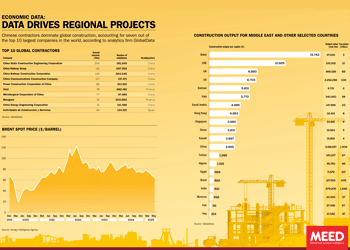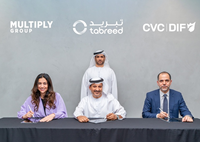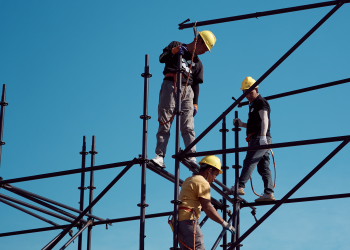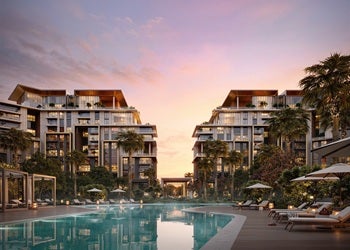Saudi lenders gear up for corporate growth
13 March 2024
 MEED's April 2024 special report on Saudi Arabia includes:
MEED's April 2024 special report on Saudi Arabia includes:
> GVT & ECONOMY: Saudi Arabia seeks diversification amid regional tensions
> UPSTREAM: Aramco spending drawdown to jolt oil projects
> DOWNSTREAM: Master Gas System spending stimulates Saudi downstream sector
> POWER: Riyadh to sustain power spending
> WATER: Growth inevitable for the Saudi water sector
> CONSTRUCTION: Saudi gigaprojects propel construction sector
> TRANSPORT: Saudi Arabia’s transport sector offers prospects

As Saudi Arabia’s once rapacious mortgage market slows down, lenders in the kingdom are building up their corporate loan books.
Banks’ exposure to the retail market is steadily reducing as the growth of the mortgage market – the big driver of credit growth in recent years – abates. Saudi lenders reported mortgage lending growth of 8% in the first nine months of 2023, compared to 19% in September 2022.
And where once the split between new business booked by Saudi banks was weighted 60:40 on retail and corporate, the split in 2023 was 50:50.
“We have noticed a decrease in Casa (current account and savings accounts). It used to be almost 70% a couple of years ago, but now it is close to 50%, and it means that the cost of funding is growing too,” says Anton Lopatin, senior director, financial institutions at Fitch Ratings.
Changing landscape
One component of this is the moderation of mortgage financing on the back of tightening subsidies and higher interest rates. “In general, the affordability of mortgage financing is less now and we see banks switching their focus to corporate lending. There’s a bit of reshuffling going on and we think that about 60% of the financing growth in 2024 will be from the corporate sector,” says Lopatin.
While Saudi Arabia's Vison 2030 projects have yet make little impact on local banks’ loan books, the expectation is that this will change, and that major economic diversification initiatives will yield good business for Saudi banks.
In the meantime, these lenders must deal with some near-term challenges in 2024, notably higher liquidity – a contrast to the situation in 2022, when financing growth of 14% outpaced deposit growth at 9%, and higher interest rates intensified competition for funding, according to Fitch Ratings. Data from the Saudi Arabian Monetary Agency (Sama) shows that the kingdom’s money supply surged 10% in January 2024 to reach SR2.72tn ($726bn).
That growth was primarily driven by a significant rise in banks’ term and savings accounts, which recorded a rise of 31% to reach SR864.32bn ($230.4bn). These deposits have attracted savings looking for higher yields.
Government reallocation
Another trend has been that government-related entities (GREs) have made moves to increase deposits in the banking system. According to Fitch, liquidity has been supported by increased deposit inflows from GREs, which grew by SAR147bn ($39.2) or 23% in the 12 months to the end of October 2023. Another ratings agency, S&P, noted that the contribution of government and GRE deposits increased to 30% of the total by 2023 from almost 20% in 2020.
According to Fitch, these inflows are mainly term deposits, which are an expensive source of funding for banks. This increase, plus higher competition for funding, has significantly raised the average cost of funding for Saudi banks; it rose to 2.7% in the first nine months of 2023, compared to just 0.4% in 2021.
“There’s been a change in how the Saudi authorities are managing GRE liquidity,” says Lopatin, who notes that GREs are now choosing to invest their surplus liquidity in higher income-generating deposits with commercial banks, rather than with Sama.
“Since July last year, we’ve seen a significant increase in government-related deposits in the banking sector. And we understand they have adjusted this approach, and now the government entities directly deposit with banks, instead of using the central bank as an additional chain into distribution of liquidity. That is also more efficient.”
Challenging conditions
Banking conditions in Saudi Arabia are looking more challenging in 2024 than in previous years. As Fitch notes, Saudi banks on average saw financing growth slightly above 10% for 2023, and the expectation is that growth will also be about 10% in 2024 – below the expansion of 14% seen in 2022.
Some banks that used to have stronger net margins have reported declines because of the focus on mortgage financing –which is under fixed rates in the kingdom – in conjunction with an increased cost of funding on the back of a declining proportion of Casa accounts. For example, Al Rajhi Banking & Investment Corporation reported that funding costs increased by 74% in year-on-year terms in 2023.
“Al Rajhi’s margins were under pressure last year but are now roughly in line with the sector average of 3.2%,” says Lopatin.
In general, UAE banks reported stronger margins than Saudi banks in 2023, says Lopatin. This is because, in combination with tightening liquidity, Saudi lenders have less ability to manage their margins.
Corporate lending in the kingdom will likely receive a boost from Vision 2030 projects.
“We expect more Vision 2030-related financing to appear on banks’ books this year. It’s still not very material, but most banks want to participate as they see these projects as having a decent balance between risk and reward,” says Lopatin.
Rating agency S&P has said that Saudi banks will need stronger access to international capital to sustain growth and continue financing projects related to Vision 2030. For now, the dependence of Saudi banks on external funding is limited.
Over the long-term, if Saudi banks do build more external debt, that could pose another challenge. International investors now have sustainability at the centre of their investment mandates, and local lenders will also need to look more seriously at their own sustainability metrics.
For example, last year, a panel of UN-appointed human rights specialists was reported to have sent letters to Saudi Aramco and financiers including Citi, Goldman Sachs and BNP Paribas, noting that their financing of the state energy company may be in violation of global human rights rules due to the company’s contribution to climate change. The letter urged the banks to take reasonable steps to prevent or mitigate the impact.
If Saudi banks do become major lenders to Vision 2030 schemes, and therefore need to source funds from outside the kingdom, they too will have to acclimatise to the new global reality – even if that is not a pressing requirement right now.
Exclusive from Meed
-
 June 2025: Data drives regional projects
June 2025: Data drives regional projects30 June 2025
-
 UAE-Turkiye financial links strengthen
UAE-Turkiye financial links strengthen30 June 2025
-

-
 Iraq approves Basra housing project
Iraq approves Basra housing project30 June 2025
-
 Meraas announces Dubai City Walk expansion
Meraas announces Dubai City Walk expansion30 June 2025
All of this is only 1% of what MEED.com has to offer
Subscribe now and unlock all the 153,671 articles on MEED.com
- All the latest news, data, and market intelligence across MENA at your fingerprints
- First-hand updates and inside information on projects, clients and competitors that matter to you
- 20 years' archive of information, data, and news for you to access at your convenience
- Strategize to succeed and minimise risks with timely analysis of current and future market trends

Related Articles
-
 June 2025: Data drives regional projects
June 2025: Data drives regional projects30 June 2025
Click here to download the PDF
Includes: Top 10 Global Contractors | Brent Spot Price | Construction output
To see previous issues of MEED Business Review, please click herehttps://image.digitalinsightresearch.in/uploads/NewsArticle/14171168/main.gif -
 UAE-Turkiye financial links strengthen
UAE-Turkiye financial links strengthen30 June 2025
 This package on UAE-Turkiye relations also includes:
This package on UAE-Turkiye relations also includes:> UAE-Turkiye trade gains momentum
> Turkiye’s Kalyon goes global

Turkish bank DenizBank is one of Turkiye’s leading private banks and, as a wholly owned subsidiary of Emirates NBD since 2019, it is playing a leading role in developing business links between the UAE and Turkiye.
Recep Bastug, who was appointed as DenizBank’s CEO in 2024, says there is great potential for trade between the two countries.
“Turkiye is a growing country,” he says. “We’ve had volatility over the past five years, but the Turkiye economy and the banking sector have been able to manage those periods successfully.”
Having spent years with international institutions such as BBVA, Bastug has vast experience in the banking sector. “Turkish banks, especially private ones like DenizBank, are very successful. In terms of capital, balance sheet structure and digital transformation, we are in a strong position,” he says.
 Solid fundamentals
Solid fundamentalsTurkiye’s fundamentals remain solid with a diversified export-oriented economy, a young and skilled population of 85 million, and relatively low debt levels. “We are not a highly leveraged country. Our household debt-to-GDP ratio is low. With the right policy mix, we offer high potential for foreign investors,” says Bastug.
That potential is increasingly being realised through growing engagement with the GCC and the UAE. “Turkiye’s connection with the Gulf is going up, and DenizBank is set to play a serious role in these relations. Day by day, Turkish companies are expanding their footprint in the region.”
GCC projects
Baştug says that many of these companies approach DenizBank to help facilitate their entry into Gulf markets. “Some of our clients are extremely well capitalised, but others need support for major projects. Just recently, one Turkish company announced a $3bn project in the region. We’re helping them connect with Emirates NBD and navigate the local financial landscape.”
DenizBank is actively supporting the creation of trilateral partnerships – particularly between Turkiye, the UAE and Saudi Arabia. “We see huge opportunity in forming financial strongholds across these markets, leveraging Turkiye’s contractor experience, the UAE’s capital and Saudi Arabia’s scale,” says Baştug.
DenizBank is already delivering results. “With Emirates NBD, we’ve identified 10 strategic cooperation areas, including trade finance, payments and capital markets. Thanks to this partnership, Emirates NBD has become the number one debt capital markets bank in Turkiye, even ahead of global players.”
One area of growing activity is initial public offering (IPO) participation. “We’ve launched a mutual fund that allows Turkish private banking clients to participate in IPOs from the region, including from the UAE and Saudi Arabia. It’s a diversification strategy and helps retain wealth within the group.”
Turkiye’s connection with the Gulf is going up, and DenizBank is set to play a serious role in these relations. Day by day, Turkish companies are expanding their footprint in the region
Recep Bastug, DenizBankInflation ends
Despite the current inflationary environment, Bastug says there is a clear inflection point ahead. “We expect 2027 to be a turning point. Once we exit the inflationary accounting regime [in Turkiye], DenizBank will become one of the biggest contributors to Emirates NBD’s global balance sheet. Last year, we contributed $1.2bn. In 2027, it will be significantly more.”
DenizBank is the fifth-largest private bank in Turkiye with about a 5% market share. “The largest private bank is at 13%. It’s not easy to close that gap – but we will do it. Our long-term goal, aligned with our shareholder, is to become the biggest and most successful private bank in the country.”
The bank is especially focused on agriculture, SMEs, and export financing – sectors that are deeply relevant to
Turkiye’s economic growth and to regional demand. “We are the leading agricultural bank in Turkiye, and we believe strongly in the sector’s future – both for local consumption and exports.”Regional opportunities
Bastug also sees potential for engagement beyond the GCC, including in post-conflict reconstruction. “In the past, Turkiye had strong trade volumes with Syria. Even during wartime, commercial links remained. Once a stable environment emerges, there will be opportunities – especially in infrastructure.”
While a physical branch presence is not currently being considered, DenizBank is prepared to support Turkish contractors operating in neighbouring countries. “We have the relationships and expertise to facilitate this growth. And culturally, we’re well aligned with the region – it helps make business smoother.”
As Turkiye re-establishes economic momentum and Gulf economies look to deliver on long-term visions, DenizBank is positioning itself for a more active role in the region in the future. “We are preparing the bank for the next stage, and with the backing of Emirates NBD, we’re confident in our ability to lead.”
READ MORE
> UAE-Turkiye trade gains momentum
> Turkiye’s Kalyon goes globalhttps://image.digitalinsightresearch.in/uploads/NewsArticle/14170372/main.gif -
 Multiply agrees to sell Pal Cooling to Tabreed and CVC
Multiply agrees to sell Pal Cooling to Tabreed and CVC30 June 2025
Abu Dhabi-based investment company Multiply Group has agreed to sell all of its shares in its district cooling subsidiary Pal Cooling Holding (PCH) for AED3.8bn ($1bn) to a consortium comprising Engie-backed National Central Cooling Company (Tabreed) and CVC DIF.
The transaction is still subject to regulatory approvals.
MEED exclusively reported in May that a team comprising Tabreed and CVC was holding exclusive discussions to acquire PCH.
Multiply Group initially acquired a 100% stake in PCH and its subsidiaries in July 2021.
Multiply Group has been advised by Standard Chartered and Clifford Chance. Tabreed and CVC DIF have been advised by Citi, Synergy Consulting and White & Case.
The transaction brings together two of the UAE’s leading district cooling players. PCH was founded in 2006 and operates five active district cooling plants across the UAE. The company maintains eight long-term concessions and strategic partnerships with some of the UAE’s leading real estate developers, servicing key residential, commercial and mixed-use developments – most notably on Abu Dhabi’s Reem Island.
Tabreed owns and operates 92 plants, including 76 in the UAE, five in Saudi Arabia, eight in Oman, one in Bahrain, one in India and one in Egypt, in addition to other international projects and operations.
https://image.digitalinsightresearch.in/uploads/NewsArticle/14170511/main.jpg -
 Iraq approves Basra housing project
Iraq approves Basra housing project30 June 2025
Iraq has approved plans to build a housing project in Basra that will offer about 5,000 homes in the first phase to tackle the country’s rising housing shortage.
The project, which is endorsed by Iraq’s National Investment Commission (NIC), will cover an area of about 3 square kilometres.
According to local media reports, Basra province governor Asaad Al-Idani said the project has already been awarded to a developer.
Iraq has been gradually recovering since the war. The government initially prioritised infrastructure and public housing to stimulate economic growth, improve living standards and attract foreign investment.
More recently, benefitting from higher oil prices and a period of relatively stable governance, Baghdad has expanded its focus to reconstructing and modernising the country’s deteriorating infrastructure.
The Iraqi construction market has also seen significant investments from private real estate developers from the region. In May, Egyptian real estate developer Ora Developers announced that it had started construction on the Al-Wardi residential city project, which consists of more than 100,000 residential units covering about 61 million square metres (sq m) on the southeastern side of Baghdad.
The move is the latest sign of international investors’ growing appetite for developing real estate in Iraq as part of the country’s post-war building initiatives.
Also in May, another Egyptian firm, Talaat Moustafa Group Holding, said it was in negotiations with the NIC to develop a mixed-use project. The project, which will cover an area of about 14 million sq m and will be located in the southwest of Baghdad, is expected to contain about 45,000 residential units.
The positive sentiment has been particularly buoyed by a robust 2024 budget, which allocated nearly $42bn to transport, social infrastructure and housing initiatives.
Looking ahead, Iraq’s construction industry is expected to register an annual average growth rate of 4.9% in 2025-28, supported by further investments in energy, infrastructure and housing projects, according to UK analytics firm GlobalData.
MEED’s June 2025 report on Iraq includes:
> COMMENT: Iraq maintains its pace, for now
> GOVERNMENT & ECONOMY: Iraq’s economy faces brewing storm
> OIL & GAS: Iraqi energy project value hits decade-high level
> PIPELINES: Revival of Syrian oil export route could benefit Iraq
> POWER: Iraq power sector turns a page
> CONSTRUCTION: Iraq pours billions into housing and infrastructure projects
> DATABANK: Iraq forecast dips on lower oil priceshttps://image.digitalinsightresearch.in/uploads/NewsArticle/14170011/main.png -
 Meraas announces Dubai City Walk expansion
Meraas announces Dubai City Walk expansion30 June 2025
Register for MEED’s 14-day trial access
Local real estate developer Meraas has announced the City Walk Crestlane project as it continues to expand its City Walk residential community in the Al-Wasl area of Dubai.
The City Walk Crestlane comprises two residential towers offering 198 one-, two-, three-, four- and five-bedroom units.
The project is expected to be completed and handed over by the third quarter of 2028.
Earlier this month, Meraas, which is part of Dubai Holding Real Estate, awarded a construction contract for another project at City Walk.
The local firm Naresco Contracting was awarded a AED450m ($123m) contract for the main construction works on its Central Park Plaza residential project at City Walk.
The project involves constructing two towers with 23 and 20 floors. Together, they will have 212 residential units.
In May, Meraas awarded another local firm, Al-Sahel Contracting Company, a AED300m contract for the main construction works on Elara, which is phase seven of the Madinat Jumeirah Living masterplan in Dubai.
The project involves building three residential towers with 234 apartments.
https://image.digitalinsightresearch.in/uploads/NewsArticle/14169472/main.jpg


